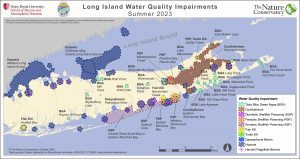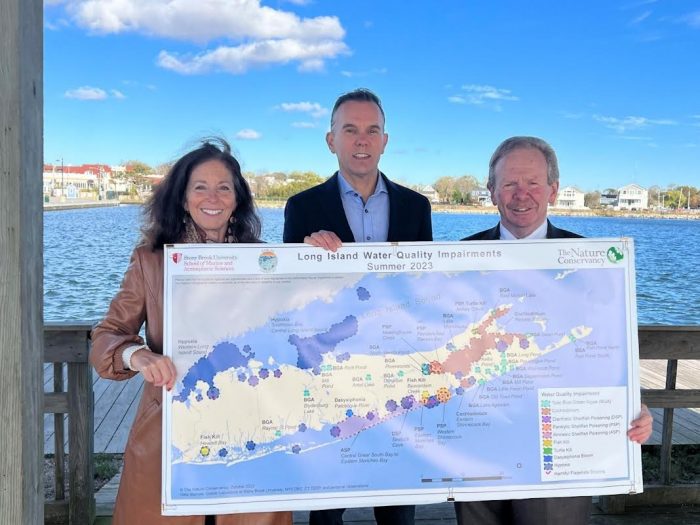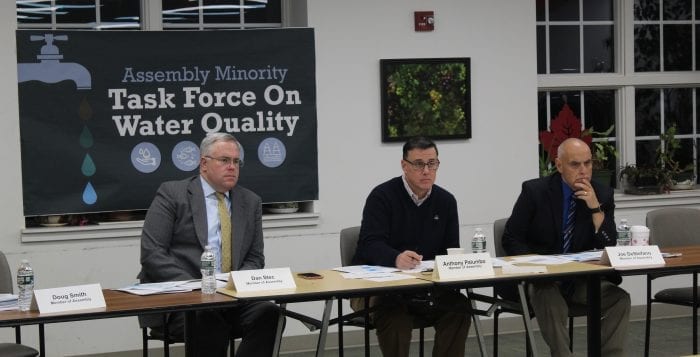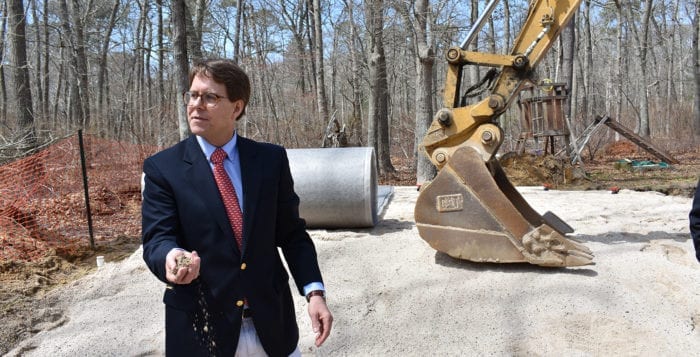New 2023 Map Shows Record Number of Harmful Algal Blooms and Dead Zones Across Long Island
Scientists at Stony Brook University have completed their assessment of water quality in Long Island’s surface waters for 2023 and the news was not good –the announcement was made today at a press conference on the shores of Great South Bay. During the months of April through September, every major bay and estuary across Long Island was afflicted by harmful algal blooms (HABs), oxygen-starved, dead zones, and fish and turtles kills. Excessive delivery of nitrogen from onsite wastewater has been cited as the root cause of these disturbing events.
“Some aspects of 2023 were the ‘new normal’ for Long Island, but there were disturbing, unexpected outcomes as well” said Dr. Christopher Gobler, Professor of Stony Brook University. “This was the worse year for harmful algal blooms on Long Island, ever.”
Gobler explained that there was a record-setting five shellfish bed closures in five locations covering thousands of acres across Long Island due to the occurrence of blooms of the saxitoxin-synthesizing alga, Alexandrium. Saxitoxin causes the human health syndrome, paralytic shellfish poisoning. These five closures in April and May were following by an additional closure that began in May and extended into the summer that was caused by a bloom of Dinophysis in Moriches Bay that reached record densities.Dinophysis contains okadaic acid, a gastrointestinal toxin and the 2023 bloom was record-setting.
“While a Dinophysis bloom in the Flanders Bay region in 2011 had been globally deemed the most intense Dinophysis HAB ever recorded at two million cells per liter, the event in Moriches Bay exceeded 100 million cells per liter, and sustained densities in the millions for over a month.”, commented Gobler.
On the heels of these spring events came something new for Long Island, namely a HAB called Pseudo-nitzschia that contains a neurotoxin known as domoic acid that causes amnesic shellfish poisoning. The bloom covered south shore regions from Islip through Quogue across much of Great South Bay, all of Moriches Bay, and western Shinnecock Bay. Beyond detecting tens of millions of cells per liter, this bloom was also producing the toxin domoic acid, representing a new public health threat.
“This algal toxin has never been seen in Long Island waters and has had significant mortality effects on marine mammal on the west coast. Its high density in regions that had been previously flushed by the New Inlet that closed in 2023 suggests that, in addition, to excessive nitrogen loads, poor flushing contributed to this event.”, said Gobler.
And the HABs did not stop there. In mid-July, a rust tide began on the east end of Long Island, starting in Shinnecock Bay and ultimately spreading through all of the Peconic Estuary. Rust tide is caused by the alga, Cochlodinum, that is ichthyotoxic, meaning it can kill fish and has been responsible for fish and shellfish kills on Long Island. The 2023 rust tide was the earliest start ever for a Rust Tide, and this was also the longest lasting rust tide as the event extended into early October. In 2012, the Gobler lab published an article in an international, peer-reviewed journal identifying the ability of excessive nitrogen to intensify these HABs, and in a 2019 publication, they identified the increase in summer water temperatures since the 20th century as a factor allowing these blooms to occur all summer in NY waters.
The HABs also extended inland in 2023 as there were more than were two-dozen lakes and pind that experienced outbreaks of blue-green algal blooms, a serious concern for both human and animal health. The south fork of Long Island was called out for hosting the ‘Dirty Baker’s Dozen’ as 13 water bodies in this region experienced these toxic blooms in 2023. For the past seven years, Suffolk County has had more lakes with blue-green algal blooms than any other of the 64 counties in New York State, a distinction that is likely to be repeated in 2023. Blue-green algae make toxins that can be harmful to humans and animals and have been linked to dog illnesses and dog deaths across the US and on Long Island.
The 2023 water quality impairment map also documented more than 30 distinct low oxygen ‘dead zones’ across the north shore, south shore, and east end of Long Island. All life in the ocean outside of some bacteria require oxygen to persist, a fact motivating the NYS Department of Environmental Conservation to strive for all water bodies at all times to have no less than 3 milligrams of dissolved oxygen. All 30 dead zones failed to meet this standard. While fish kills were not widespread in 2023, a lack of oxygen did contributed fish kills in locations on the south shore.
Over the years, the occurrence of harmful algal blooms and dead zones has contributed to the collapse of critical marine habitats such as seagrass, major fisheries on Long Island such as bay scallops and hard clams, and coastal wetlands that help protect waterfront communities from the damaging impacts of storms. Groups such as The Nature Conservancy have been working for more than a decade to revive and restore these habitats and shellfish but have been challenged by events such as those witnessed during the summer of 2023.
Excessive nitrogen coming from household sewage that seeps into groundwater and ultimately, into bays, harbors, and estuaries or, in some cases, is directly discharged into surface waters, is a root cause of the maladies of 2023. Excessive nitrogen stimulates algal blooms that can, in turn, remove oxygen from bottom waters as they decay. Suffolk County and Nassau County recently completed ‘subwatershed studies’ that identified wastewater as the largest source of nitrogen to surface waters and set goals for reducing nitrogen loading from septic systems as a defense against these impairments.
Despite the gloomy news, there were some signs of hope in the data.
“In Long Island Sound, the western dead zone in 2023 was significantly smaller than it was 20 year ago thanks to sewage treatment plants removing 60% more nitrogen and reducing the flow of nitrogen into the western Sound”, said Gobler. “This proves that reductions in nitrogen loading does improve water quality.”
Counterbalancing this high note was the growth of a second dead zone in central Long Island Sound emanating from Smithtown Bay suggesting this region now needs significant reduction in nitrogen loading.
The report on the summer of 2023 was compiled by the Gobler Laboratory of Stony Brook University that has been monitoring and sampling Long Island’s waters on a weekly basis every summer since 2014. Data was also generated by the Long Island Sound Study which is funded by US Environmental Protection Agency. The data was reported weekly on News 12 and Newsday as part of their weekly Water Quality Index.
The study was supported by the Chicago Community Trust and an anonymous donor.








